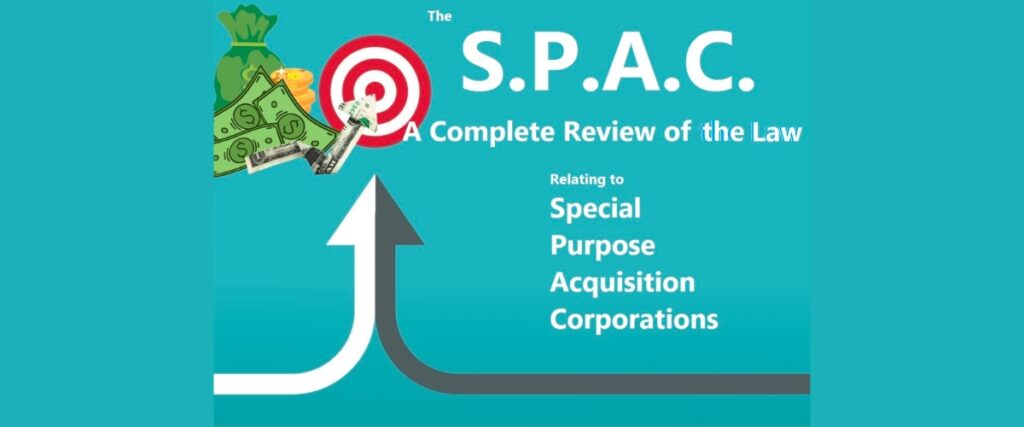This article outlines the current state of the law relating to special purpose acquisition corporations (SPAC).
- How do laws specific to Special Purpose Acquisition Corporations intersect with other legal fields?
- What is the present common law specifically relating to SPACs?
- What authoritative and argumentative writings relate to SPACs?
WHAT IS A SPAC SPECIAL PURPOSE ACQUISITION CORPORATION?

A Special Purpose Acquisition Corporation is a legal entity created for one reason: to acquire another legal entity for profit. There are many options for the legal entity to create. Options include a C-corporation, a limited liability company, a partnership, even a trust. Ordinarily a SPAC is an LLC, with the C-corporation as the second most popular choice. This is because SPACs normally seek many investors. Securities laws are more conducive LLCs and C-corporations as options for a large group of investors.
The SPAC is closely related to the business-legal field known as “private equity.” Specific, rigid rules apply to the highly profitable but risk-laden private equity field. Private equity barriers to entry include qualification as an “accredited investor,” an institutional investor,” limitations on investment, and limitations on equity sales.
The Special Purpose Acquisition Corporation was created as a means of legally bypassing private equity legal and securities impediments. In a SPAC, business insiders and experienced management teams target a pool of potential investors. Simultaneously, they target an industry they deem ripe for profit. They are then combined.
The pool of investors is coalesced into a business entity … the SPAC. Investor money is collected and pooled within the SPAC. A deadline clock of eighteen to twenty-four months is set. The investors’ money is returned (minus expenses) if the SPAC fails to acquire a targeted entity before the deadline clock expires. The SPAC and the target company merge if an acquisition does occur. The SPAC investors now own the targeted now-acquired company. This is why the SPAC is known as a “blank check company,” or “poor man’s private equity fund.” The SPAC process can be enormously profitable, or an investment loss.
Laws apply to the SPAC process. Let us review the legal landscape.
WHAT IS THE LAW RELATING TO SPECIAL PURPOSE ACQUISITION CORPORATIONS?
Constitutions, Statutes, Regulations, Ethics, and Executive Orders
The following legal authorities relate to Special Purpose Acquisition Corporations:
- The U.S. Federal Constitution
- The State Constitutions
- Federal Statutes
- State Statutes
- Federal Regulations
- State Regulations
- Ethics Opinions
- Attorney General opinions
- Executive Orders

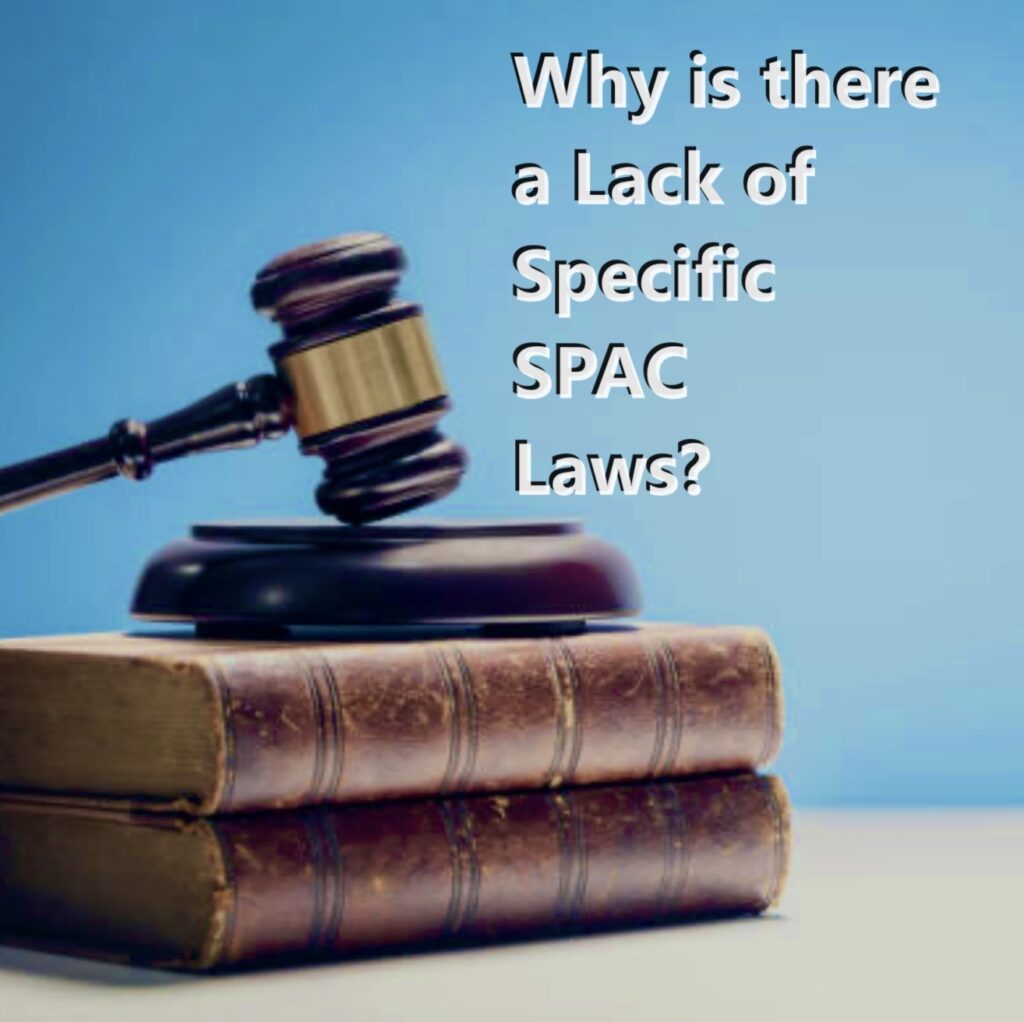
- The United States federal constitution makes to reference to the Special Purpose Acquisition Corporation.
- No State Constitution makes a reference to a SPAC.
- No federal laws (U.S.C.) specifically reference the “special purpose acquisition corporation” as of the date of this publication.
- No state laws (statutes) specifically reference the SPAC.
- No federal regulations (CFR) specifically reference the SPAC.
- No state regulations (CSR) specifically reference the “special purpose acquisition corporation” as of the date of this publication.
- No Ethics opinions (surprisingly) reference a SPAC.
- No Attorney General (federal, state) opinions reference a SPAC.
- No Executive Orders (President, Governor) reference a SPAC.
Why is the law so sparce relating to Special Purpose Acquisition Corporations? It is because the SPAC is a creation that combines legal concepts covered by existing laws, regulations, rules and opinions. These legal concepts include business law (C-companies, LLCs, LPs, S-corporations), and securities laws (1933 Act, 1934 Act, 1940 Act, Regulation D, A+). A business lawyer must look deeper to research what legal authorities apply to a SPAC
Regarding application of business law, the Operating Agreement, and the By-Laws of the SPAC bear more legal importance to SPAC problem analysis than contract provisions. Regarding application of securities laws, how the business is acquired by the SPAC is of critical importance.
- Will it be a Regulation D private placement?
- Will it be a Regulation A+ JOBS Act transaction?
- Is the transaction a Regulation Crowdfunding online general public offering?
- Where are the investors domiciled?
- Are the investors wealthy accredited investors?
- How much will each investor contribute?
- What is the goal for the total amount to be raised?
All these factors are critical to analyzing what securities laws will apply to a SPAC.
Just because there are no federal or state statutes that specifically reference the Special Purpose Acquisition Corporation does not mean that no statutes apply. The legal reality is the opposite. There are libraries for corporate and securities laws that apply to Special Purpose Acquisition Corporations.
The Common Law: Court Judicial Opinions Specific to a SPAC
The following common law United States court decisions specifically relate to Special Purpose Acquisition Corporations as of the date of this publication:
- Jaar v. Genesis Acquisition Corp., 24-cv-02155 (JLR) (S.D.N.Y. Jul. 1, 2024)
- In re Paysafe f/k/a/ Foley Trasimene Acquisition Corp. II Sec. Litig., 21-cv-10611 (ER) (KHP) (S.D.N.Y. Apr. 16, 2024)
- Lucas v. Kapstone Paper & Packaging Corp., 894 S.E.2d 831 (S.C. App. 2023)
- Kusnier v. Virgin Galactic Holdings, Inc., 21-CV-3070 (ARR) (TAM) (E.D. N.Y. Dec. 19, 2023)
- In re Grab Holdings Sec. Litig., 1:22-cv-02189 (JLR) (S.D. N.Y. Mar. 12, 2024)
- In re Lottery.com Sec. Litig., 1:22-cv-07111 (JLR) (S.D. N.Y. Feb. 6, 2024)
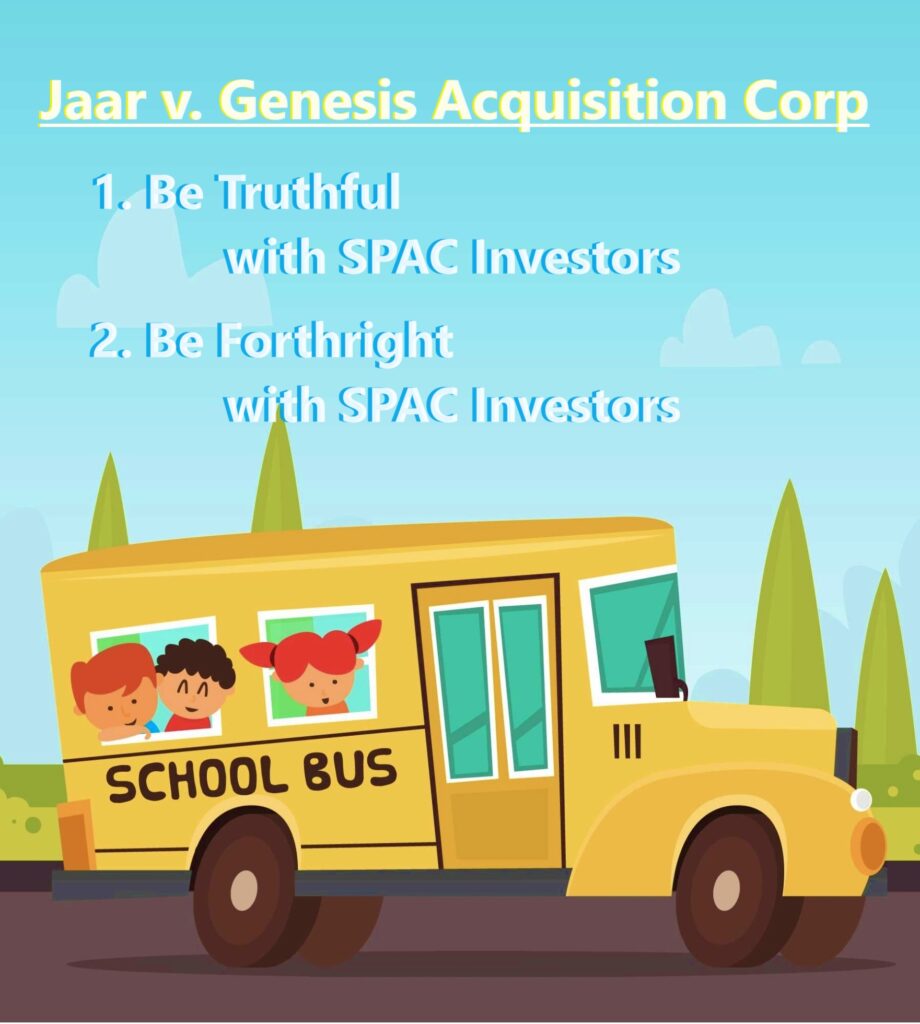
Jaar v. Genesis Acquisition Corp. – Do not lie to your SPAC investors
In March of 2024, Jacques Jaar the SPAC’s largest investor, representing the entire class of investors sued Northern Genesis Acquisition Corporation. This SPAC had purchased Lion Electric, a designer, manufacturer, and direct seller of school buses and trucks.
Jaar’s lawsuit alleges violations of the Securities Exchange Act of 1934 (15 USC 78), and the PSLRA Private Securities Litigation Reform Act of 1995 (15 USC 78u-4, et seq.). Jaar alleged the SPAC published misleading statements, omitted supply chain problems, and poor financial prospects. Once revealed, the stock price plummeted causing the SPAC investors to lose their redemption rights and money.
In re Paysafe – Do not mislead your SPAC investors
In February 2022, this putative securities class action was filed against FTAC, the Foley Trasimene Acquisition Corporation II. Between December 2020 and March 2021, FTAC had merged with Paysafe Group Holdings Limited. Paysafe was a Bermuda company providing end to end merchant-customer payment solutions. The merged company, calling itself Paysafe Limited expanded to digital wallets, e-commerce digital payments, online gambling, and gaming. The company issues press releases advertising anticipated double digit growth in revenue and payment volume. Investors got excited and bought the SPAC’s stock shares on the New York Stock Exchange.
Paysafe revised its press releases down in November 2021, citing European gambling regulation issues, digital wallet performance problems, and the need to revise its customer agreements. Paysafe’s stock immediately fell by more than forty percent (40%).
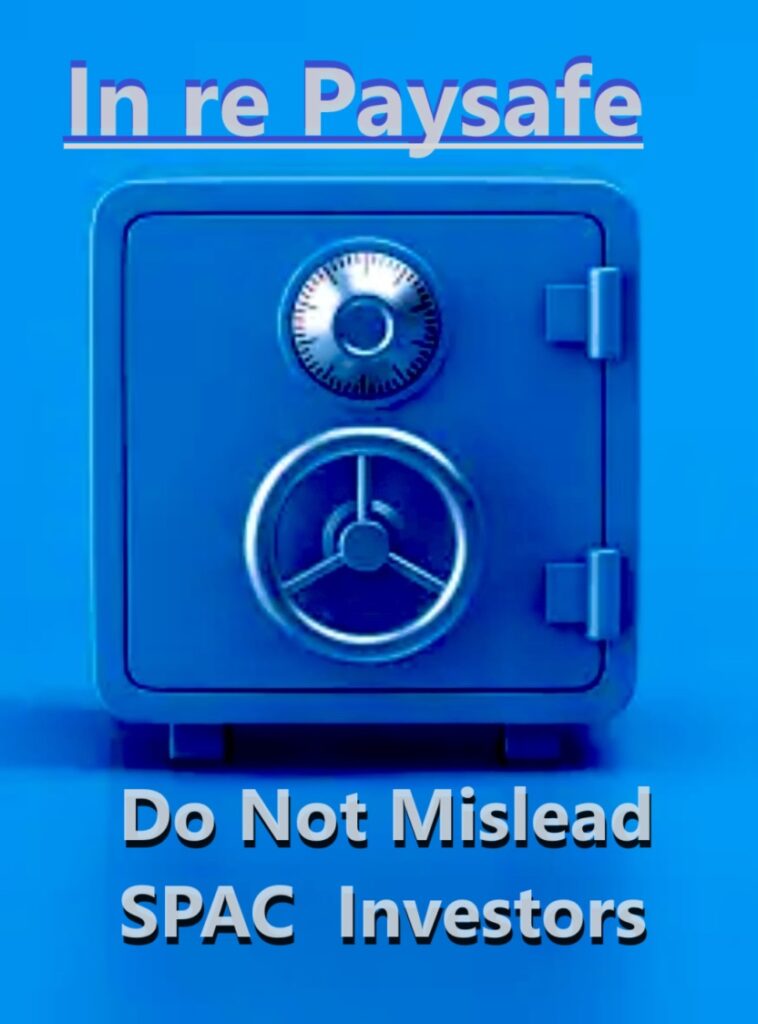
The largest SPAC investors sued Paysafe for violations of sections 10(b) and 20(a) of the Exchange Act (15 USC §§ 78j(b), 78t(a), and SEC Rule 10b-5 (17 CFR §240.10b-5). The SPAC investors allege Paysafe disseminated false and misleading information to lure them into buying its overvalued stock.
Lucas v. KapStone Paper and Packaging Corporation – The Parent SPAC Usually Gets the Immunity of its Acquired Subsidiary
The Lucas case is important to situations where employees of the acquired entity want to sue the acquiring SPAC entity for on-the-job injuries, and those employees have received workers compensation.
A horrific burn accident occurred on May 24, 2016 at the KapStone paper mill in Charleston, S.C.. A large overhead vessel was accidently opened, pouring searing hot black liquor onto the paper mill’s employees. Extensive medical treatment, skin grafts, and treatment for the psychological was needed.
Worker’s compensation claims were filed on behalf of the employees, where they received employer-paid medical treatment, lost wages, and compensation for their permanent, partial disabilities. The employee victims next filed their personal injury lawsuit in February of 2017. Worker’s compensation laws give the employer immunity from personal injury (tort) lawsuits. Instead, the Lucas employee-victims filed their lawsuit against KapStone’s parent company, Kraft.

Was the parent company immune from being sued because its subsidiary paid through worker’s compensation? This was the issue presented in the Lucas case. Under the law, a parent company is generally not immune from a tort (intentional civil wrongdoing) just because its subsidiary paid through worker’s compensation. 82 Am. Jur. 2d Workers’ Compensation § 90 (2003) However, there is an exception to this rule. The immunity of the subsidiary (that participated in worker’s compensation) can be imparted to its parent company when the two entities are “alter egos.” Monroe v. Monsanto Company, 531 F. Supp. 426 (D.S.C. 1982). In essence, the parent and its subsidiary must operate as “one economic entity” to share lawsuit immunity.
In Lucas, KapStone Paper and Packaging Corporation was a Delaware Special Purpose Acquisition Corporation (SPAC). The KapStone SPAC acquired Kraft paper manufacturing. The new entity group operated as an integrated, unified network. The same Board of Directors, corporate officers, and meetings controlled and managed the entity group.
Kapstone/Kraft made a Motion to Dismiss the personal injury claims of the Lucas employees. The motion alleged that KapStone and Kraft were one economic entity. Worker’s compensation benefits had been paid to the Lucas employees by the Kraft entity, therefore the KapStone entity shared in Kraft’s tort lawsuit immunity.
The status of the Kraft/Kapstone merger through a Special Purpose Acquisition Corporation (SPAC) helped. Merriam-webster’s dictionary defines a SPAC as “a corporate shell set up by investors for the sole purpose of raising money through an initial public offering to acquire another business yet to be determined.” Black’s Law Dictionary further supports the unified entity theory as defining a “shell corporation” as “[a] corporation that has no active business and usu[ally] exists only in name as a vehicle for another company’s business operations.” Thus, by definition, once merged, a SPAC and the entity it has acquired are one, unified, integrated entity.
The Lucas trial court applied a multi-factor test, determining that the two entities were in fact “one economic entity,” granted the motion, and dismissed the lawsuit. The Lucas employees appealed. On November 15, 2023, the Court of Appeals of South Carolina agreed with the trial court and affirmed the lawsuit’s dismissal.
Kusnier v. Virgin Galactic Holdings, Inc., – Time of Investment Matters, when Making Misleading Statements to Investors
Virgin Galactic Holdings, Inc. is a private space company. Its goal is to send commercial vehicles to space. Two stages are employed. One vehicle lofts to 45,000 feet. A second vehicle lofts to 275,000, spends a short time in space, and returns, all for a ticket price.
Virgin Galactic had a history of disasters and near disasters leading to deadly and nearly deadly space flight attempt mishaps between 2004 and 2020. Virgin Galactic issued positive press releases advertising “safely to space and back” in spite of its dangerous flight record.
Social Capital Hedosophia Holdings Corporation (Social Capital) emerges. Social Capital is a Special Purpose Acquisition Corporation (SPAC) created for the sole purpose of acquiring Virgin Galactic and taking it public for investor profits. The merger transaction between Social Capital and Virgin Galactic transpired between July and October of 2019, with numerous positive press releases issued by Virgin Galactic during this process.
Richard Branson, founder of Virgin Galactic enters. In July 2021, post merger with social Capital, Mr. Branson flies into space on a Virgin Galactic ship. The space vehicle encounters dangerous deviations from its flight path attempting to safely return to Earth. The merged Virgin Galactic-Social Capital entity, instead, advertises the trip as an unmitigated success, labeling its near miss as “perfect,” and “flawless.”
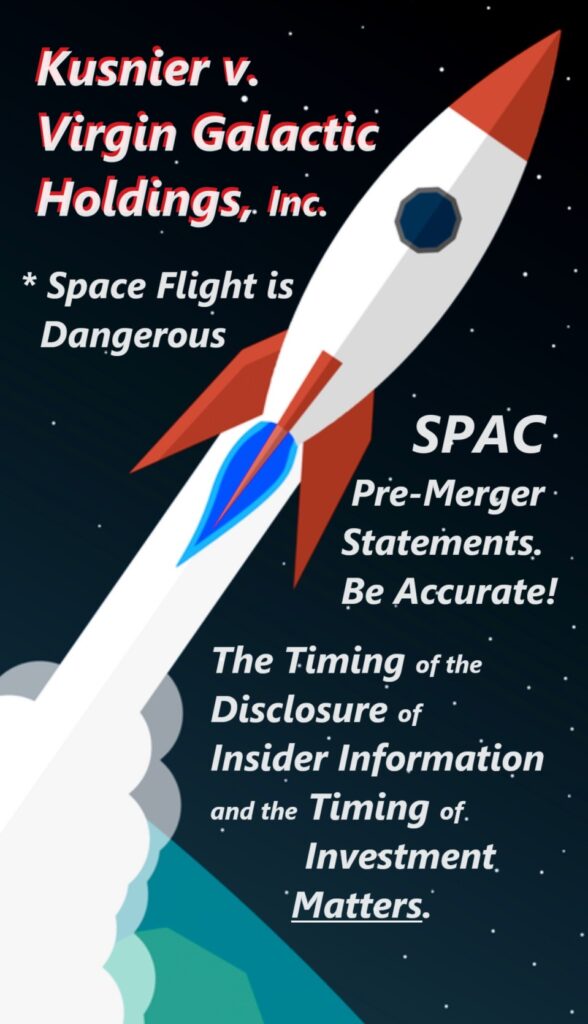
The investors sue, alleging securities fraud, and insider trading. Virgin Galactic moved to dismiss any fraud claims relating to pre-merger statements. The District Court agreed, and ordered a partial fraud claims dismissal.
Virgin Galactic also moved to dismiss the insider trading claims under SEC Rule 10b-5 relating to §10(b) of the Securities and Exchange Act of 1934. These claims were directed at founder Richard Branson, who sold stock while possessing material non-public information, namely relating to safety issues with the space flights. The court dismissed these claims citing that Mr. Branson’s insider information had become public by the time of his stock sale. In short, “purchasers of a security of an acquiring SPAC cannot sue under §10(b) for misstatements by the acquired company prior to the merger.
- 15 U.S.C. §78j
- 17 C.F.R. §240.10b-5
- Menora Mivtachim Insurance v. Frutarom Industries, 54 F4th 82 (2nd 2022)
- Blue Chip Stamps v. Manor Drug Stores, 421 U.S. 723, 731 (1975)
- Ontario Pub. Serv. Emps. Union Pension Tr. Fund v. Nortel Networks Corp., 369 F.3d 27, 31 (2d. Cir. 2004)
Here, the Social Capital SPAC acquired Virgin Galactic. The merged company went public. The investors invested. Any misleading statements by the entities had been revealed by the time of the investments. Any insider information that would harm investors had become public before their investments. The investors lacked “standing” and their claims in that regard were dismissed.
In re Grab Holdings Sec. Litig., – Good Overview of the SPAC process
This lawsuit alleges violations of Section 11 and 15 of the Securities Act of 1933. (15 U.S.C. §77k, 15 U.S.C. §770). The lawsuit also alleges violations of sections 10(b), and 14(a) of the Securities Act of 1934, and S.E.C. Rules 10(b), and 14a-9 (C.F.R. §78j(b), §240.14a-9). Defendants achieved a partial motion to dismiss the claims against them.
The Grab Holdings Court gave a good overview of the essence of Special Purpose Acquisition corporations. The Grab Court stated:
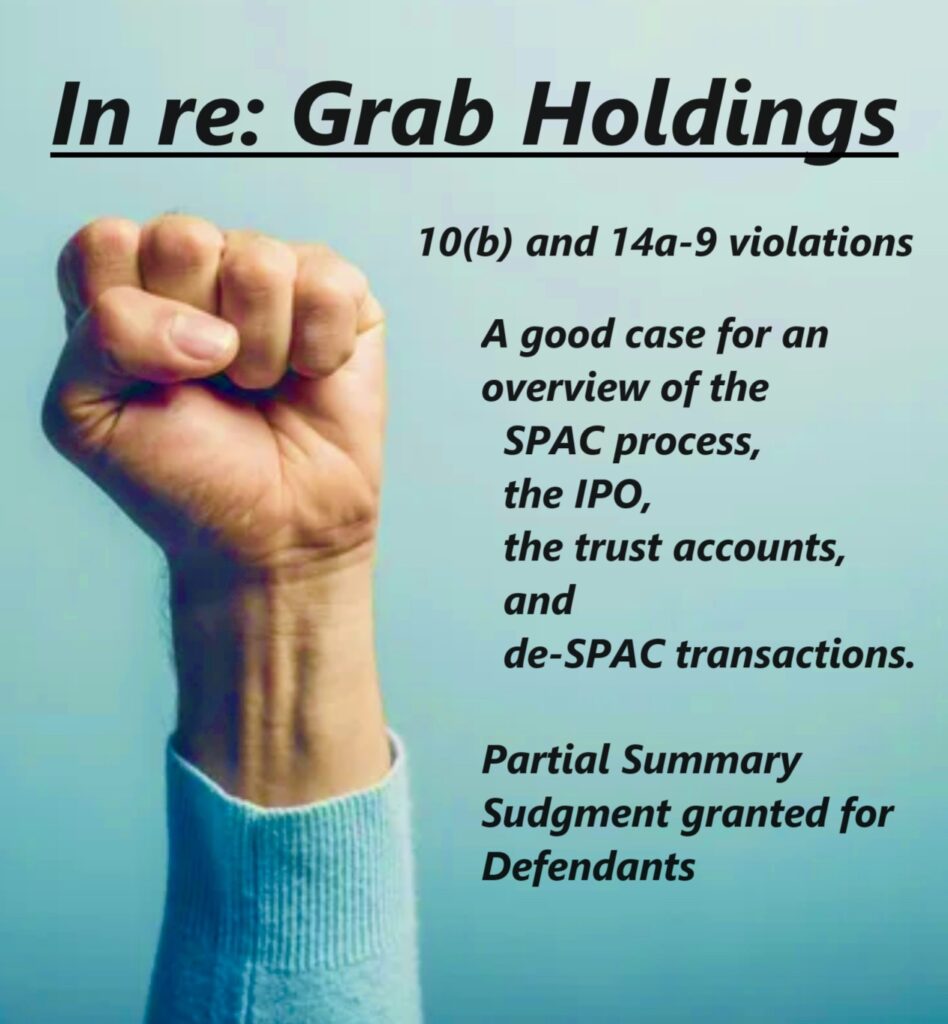
A special-purpose-acquisition corporation (a “SPAC”) is a type of “shell company.” Am. Compl. ¶ 31. Following its formation, a SPAC conducts an initial public offering (an “IPO”) through a conventional underwriting. Id. In addition to common stock, “[i]nitial investors also commonly obtain warrants to buy additional stock as at a fixed price, and sponsors of the SPAC obtain a ‘promote’ – [that is,] greater equity than their cash contribution or commitment would otherwise imply.” Id. The proceeds from these sales are deposited in a trust account for the sole purpose of funding the acquisition of a private company. Id. “SPACs usually have an 18-to-24-month period to find an acquisition target.” 1 Thomas Lee Hazen, Law Sec. Reg. § 3:58 (Westlaw database updated Nov. 2023). The resulting business combination “is often referred to as a de-SPAC transaction.” Id.; accord Am. Compl. ¶ 31. A de-SPAC transaction thus offers a private company seeking to go public an alternative to undertaking a traditional IPO. Am. Compl. ¶ 34. “If a merger is completed within the allocated time frame, founders and managers of the SPAC generally reap windfall profits from their ownership of SPAC securities they obtained cheaply prior to public offering, and enjoy considerable control such as the ability to nominate board members to the new company.” Id. ¶ 32. But “if an acquisition is not effectuated within that time frame, then the SPAC is dissolved and the money in the trust is returned to investors, with no compensation paid to the founders and managers of the SPAC.” Id.

In re Lottery.com – Investors Can Sue for False statements, Misleading statements, and Silence when there is a Duty to Disclose, But Investors Cannot Sue for Forward Looking Statements or for Opinions.
This was a class action lawsuit against Lottery.com, formerly Trident Acquisitions Corporation, a Special Purpose Acquisitions Corporation (SPAC). Two lawsuits were consolidated alleging violations of:
- 10(b)of the Securities Act of 1934 (15 U.S.C. §78j(b)
- SEC Rule 10b-5
- 20(a) of the Securities Act of 1934 (15 U.S.C. §78t(a)
- 14(a) of the Securities Act of 1934 (15 U.S.C. §78n(a)
- SEC Rule 14a-9 (17CFR §240.14a-9
Defendants Trident and Lottery.com moved to dismiss the lawsuit. Their motion was granted in part, but the suing investors were given the right to amend their pleadings to correct their mistakes.
This lawsuit results from an economic issue with compensation in Special Purpose Acquisition Corporations. SPAC founders and management team are highly incentivized to complete an acquisition within the SPAC deadline irrespective of whether the transaction is good for the investors.
Trident Acquisitions Corporation was created in Delaware in 2016. Its goal was to acquire an oil or gas company in Eastern Europe. Trident’s initial public offering (IPO) occurred in 2018 and traded on NASDAQ.
Trident had a deadline of December 2019 to acquire a company. The Trident SPAC was required to cease operations, wind up its business, redeem the shares of the investors, liquidate, and dissolve if the 12/19 deadline passed without an acquisition. Moreover, failing to meet the 12/19 SPAC deadline would cost the founders and executives millions of dollars in compensation.
The SPAC investors and management agreed to delay the December 2019 SPAC deadline by one year to December 2020. By late 2020, Trident had spent all but $62 million of the original $201 million of its capitalization with little to show for it. Management was under pressure.
Mere days before the December 2020 SPAC deadline, Trident announced its intent to acquire Lottery.com, a Texas based online platform for lottery games via a SEC Form 8-K. The SPAC met its 12/20 deadline.
Trident and Lottery.com made qualified representations to investors that the combined company would generate $70 million in revenue, $3 million in EBITDA earnings and a 32% gross profit margin. Several other representations as to the financial health of Lottery.com were made in subsequent months. These representations were determined to be false by a later, independent auditor.
SPAC investors filed two class action lawsuits in August of 2022. The lawsuits were consolidated in April of 2023 (similar underlying facts).
The SPAC investors had to pass certain legal tests to succeed in their combined lawsuit. Specifically, “Section 10(b) of the Securities Exchange Act of 1934 and the Securities and Exchange Commission’s Rule 10b-5 prohibit making any material misstatement or omission in connection with the purchase or sale of any security.” Halliburton Co. v. Erica P. John Fund, Inc., 573 U.S. 258, 267 (2014). To pass their Section 10(b) and Rule 10b-5 legal tests, suing investors must allege:
- a material misrepresentation or omission by Trivent/Lottery.com,
- scienter (a mental intent to deceive, manipulate, or defraud),
- a connection between the misrepresentation or omission and the purchase or sale of a security,
- reliance upon the misrepresentation or omission,
- economic loss, and
- loss causation.
Id.
Additionally, the suing SPAC investors must state with particularity in their Petition “the circumstances constituting fraud.” Fed.R.Civ.P. 9(b). Specifically, the suing SPAC investors were required to:
- specify the statements that they contend were fraudulent,
- identify the speaker,
- state where and when the statements were made, and
- explain why the statements were fraudulent.
15 U.S.C. § 78u-4(b)(1), In re Synchrony Fin. Sec. Litig., 988 F.3d 157, 166 (2d Cir. 2021).
Keep in mind; with securities law violations, the truth, falseness, or omission “is measured not by its literal truth, but by its ability to accurately inform rather than mislead prospective buyers.” Ark. Pub. Emps. Ret. Sys. v. Bristol-Myers Squibb Co., 28 F.4th 343, 354 (2d Cir. 2022) (“APERS”). “Whether a statement is ‘misleading’ depends on the perspective of the reasonable investor.” Omnicare, Inc. v. Laborers Dist. Council Constr. Indus. Pension Fund, 575 U.S. 175, 186 (2015). “The inquiry is objective,” Id. at 187. It considers not only a statement’s “literal truth,” but also the “context and manner of presentation,” Singh v. Cigna Corp., 918 F.3d 57, 63 (2d Cir. 2019).
Additional issues exist for the suing SPAC investors.
- Are they alleging the corporation was silent when it should have disclosed? Then, the presence or absence of a duty to disclose must be determined.
- Can the representations about which the CPAC investors complain be characterized as opinions (like puffery)? Then, there may be no duty to be accurate.
In this case, the trial court ruled that the investors suing Lottery.com failed to sufficiently identify the false statements of Trident/Lottery. Second, the investors failed to explain why the statements were false. The trial court ordered the investors to amend their pleadings to correct these defects.
Lottery.com, defending, claimed the alleged false statements were “forward looking” revenue and market statements. Iowa Pub. Emps.’ Ret. Sys. v. MF Glob., Ltd., 620 F.3d 137, 141 (2d Cir. 2010) (“IPERS I”). Lottery.com argued that since “forward looking” statements are about the future, they cannot be determined false, when made, due to the known uncertainty of the future.
The trial court agreed. It indicated that as “a general rule, statements whose truth cannot be ascertained until after the time they are made are forward-looking statements.” In re Philip Morris Int’l Inc. Sec. Litig., 89 F.4th 408, 418, 428 (2d Cir. 2023). The trial court ruled that since the Trident/Lottery statements were made before the SPAC merged, the statements were projected results. They was “forward looking” to the future and not false statements at the time stated. The forward-looking statements were neither materially false nor misleading. The trial court granted the Motion to Dismiss of Lottery.com for pre-merger statements.
The suing SPAC investors then turned to statements made after the Trident SPAC/Lottery.com merger. Specifically, they looked to the Form 8-k disclosures filed with the Securities and Exchange Commission. These financial performance and process statements were alleged to be false.
- com defended, arguing these statements, too, were forward-looking. The trial court disagreed.
- com defended, arguing the 8-k disclosures were merely opinions. The trial court disagreed.
- com defended, arguing the misleading character of its SEC 8-k disclosures was merely silence in not correcting its pre-merger representations, and silence could not be a false statement. The trial court disagreed, finding that Lottery.com had a duty to disclose in the pleaded circumstances. A reasonable investor would have been misled by the post-merger 8-k disclosures. The investors could sue.
The SPAC investors were given time to amend their pleadings. The lawsuit is proceeding.

Law Review Articles, Publications, Reports, and Books that specifically relate to Special Purpose Acquisition Corporations
Are you looking for an in-depth dive into mastering the issues, pit falls, and wealth opportunities a Special Purpose Acquisition can provide? Are you a lawyer litigating a SPAC case? I recommend you read these materials that are authoritative on the SPAC. They include:
- So the Securities Laws Actually Protect Investors (And How)? Lessons from SPACs, Patrick Corrigan (April 18, 2024) Law Review, Washington University School of Law
- https://wustllawreview.org/2024/04/18/do-the-securities-laws-actually-protect-investors-and-how-lessons-from-spacs/
- Michael Klausner, Michael Ohlrogge & Emily Ruan, A Sober Look at SPACs, 39 Yale J. on Regul. 228 (2022)
- Usha Rodrigues & Mike Stegemoller, Exit, Voice, and Reputation: The Evolution of SPACs, 37 Del. J. Corp. L. 849 (2013)
- Harald Halbhuber, Economic Substance in SPAC Regulation, 40 Yale J. on Regul. 44 (2022);
- Michael Klausner, Michael Ohlrogge & Harald Halbhuber, Net Cash Per Share: The Key to Disclosing SPAC Dilution, 40 Yale J. on Regul. 18 (2022)
- Usha Rodrigues & Michael Stegemoller, Disclosure’s Limits, 40 Yale J. on Regul. 37 (2022)
- John C. Coates, SPAC Law and Myths, 78 Bus. Law. 371 (2023)
- Usha R. Rodrigues & Michael Stegemoller, Why SPACs: An Apologia, (U. Ga. Sch. L. Legal Stud. Rsch. Paper, Paper No. 2022-04, 2022), https://papers.ssrn.com/sol3/papers.cfm?abstract_id=4072834[https://perma.cc/J8GF-Z7WT]
- Usha R. Rodrigues & Michael Stegemoller, Redeeming SPACs, 40–43 (U. Ga. Sch. L. Legal Stud. Rsch. Paper, Paper No. 2021-09, 2021) https://papers.ssrn.com/sol3/papers.cfm?abstract_id=3906196 [https://perma.cc/V8AN-L6PR] (showing data suggesting that SPAC retail investors trade in a context of unusual illiquidity)
- Amanda M. Rose, SPAC Mergers, IPOs, and the PSLRA’s Safe Harbor: Unpacking Claims of Regulatory Arbitrage, 64 Wm. & Mary L. Rev. 1757 (2023)
- Michael Klausner & Michael Ohlrogge,Is SPAC Sponsor Compensation Evolving? A Sober Look at Earnouts, (Stan. L. & Econ. Olin Working Paper, Paper No. 567, NYU L. & Econ. Rsch. Paper, Paper No. 22-10, 2022), https://papers.ssrn.com
/sol3/papers.cfm?abstract_id=4022611 [https://perma.cc/UT4H-JH89] - Andrew F. Tuch & Joel Seligman, The Further Erosion of Investor Protection: Expanded Exemptions, SPAC Mergers, and Direct Listings, 108 Iowa L. Rev. 303 (2022); Emily Strauss, Suing SPACs, 96 S. Cal. L. Rev. 553 (2023)
- Frank Fagan & Saul Levmore, SPACs, PIPEs, and Common Investors, 25 U. Pa. J. Bus. L. 103, 108 (2023) (“SPACs have evolved as a sensible way to link several steps in a process of business formation that can appeal to public investors.”)
- Robert Jackson & John Morley, SPACs as Investment Funds (July 14, 2022) (unpublished manuscript) (on file with Wharton Initiative on Financial Policy and Regulation)
- Steven L. Schwarcz, Enron and the Use and Abuse of Special Purpose Entities in Corporate Structures, 70 U. Cin. L. Rev. 1309, 1310 (2002)
- Samuel Farrell Ziegler, Note, China’s Variable Interest Entity Problem: How Americans Have Illegally Invested Billions in China and How to Fix It, 84 Geo. Wash. L. Rev. 539, 547 (2016)
- DiamondPeak Holdings Corp., Current Report (Form 8-K) (Sept. 17, 2020), https://www.sec.gov/Archives/edgar/data/1759546
/000110465920106256/tm2029038-3_8k.htm [https://perma.cc/T4UU-ZB7Q] - DiamondPeak Holdings Corp., Exhibit 99.1 to Current Report (Form 8-K) (Sept. 17, 2020), https://www.sec.gov/Archives/edgar
/data/1759546/000110465920106256/tm2029038d3_ex99-1.htm [https://perma.cc/TW8W-XFAJ] - Amrith Ramkumar, The Celebrities from Serena Williams to A-Rod Fueling the SPAC Boom, Wall St. J. (Mar. 17, 2021, 5:32 AM), https://www.wsj.com/articles/the-celebrities-from-serena
-williams-to-a-rod-fueling-the-spac-boom-11615973578 [https://perma.cc/3EVW-SY4G] - Patrick M. Corrigan, The Seller’s Curse and the Underwriter’s Pricing Pivot: A Behavioral Theory of IPO Pricing, 13 Va. L. & Bus. Rev. 335, 352 (2019), discussing how transactional innovation in SPAC markets provides issuers with an additional avenue for obtaining an above-market price for their stock in going-public transactions.
- Lora Dimitrova, Perverse Incentives of Special Purpose Acquisition Companies, the “Poor Man’s Private Equity Funds,”63 J. Acct. & Econ. 99, 118 (2017) (arguing that misaligned incentives for SPAC sponsors are a key driver of poor post-merger performance for de-SPAC companies)
- Minmo Gahng, Jay R. Ritter & Donghang Zhang, SPACs, Rev. Fin. Stud. (forthcoming) (manuscript at 24, 45), https://papers.ssrn.com/sol3/papers.cfm?abstract_id=3775847[https://perma
.cc/2WNX-42NP] - SPAC Returns Fall Short of Traditional IPO Returns on Average, Renaissance Cap. (Oct. 1, 2020), https://www.renaissancecapital.com/IPO-Center/News
/71816/Updated-SPAC-returns-fall-short-of-traditional-IPO-returns-on-average [https://perma.cc/WPY7-FTMK] - Special Report: SPAC Merger Returns Crumble, Upending the 2022 SPAC Market, Renaissance Cap. (Apr. 20, 2022), https://www.renaissancecapital.com/IPO-Center/News
/92125/Special-Report-SPAC-merger-returns-crumble-upending-the-2022-SPAC-market [https://perma.cc/JCC9-WQ3B] - Joanna Glasner, The Dollar Stock Club: Delisting Looms for These Poorly Performing SPACs, Crunchbase News (June 30, 2022), https://news.crunchbase.com/public/spac-merger-vc-backed-delisting-enjy-lotz-crxt/?utm_source=cbdium=email&utm_campaign=20220630&utm_content=intro&utm_term=content&utm_source=cb_daily&utm_medium=email&utm_campaign=20220630 [https://perma.cc/PMZ9-24HQ]
- Bailey Lipschultz, Why More than 40% of Ex-SPACs Are Running Out of Cash, Bloomberg (Oct. 5, 2022, 9:28 AM), https://www.bloomberg.com/news/articles/2022-10-05/dozens-of-de-spacs-flag-severe-cash-problems-as-economy-weakens#xj4y7vzkg[https://perma.cc/47RR-GPJV].
- Holger Spamann & Hao Guo, The SPAC Trap: How SPACs Disable Indirect Investor Protection, 40 Yale J. on Regul. 75, 77 (2022)
- Elizabeth Blankespoor, Bradley E. Hendricks, Gregory S. Miller & Douglas R. Stockbridge Jr., A Hard Look at SPAC Projections, 68 Mgmt. Sci. 4742, 4742 (2022) (finding that only 35% of firms that complete a de-SPAC merger meet or beat the projections they made in offering materials)
- Othmane Zizi, How Much the Biggest SPAC Sponsors Lost in January’s Rout, Bus. of Bus. (Feb. 4, 2022, 3:32 PM), https://www.businessofbusiness.com
/articles/how-much-the-biggest-spac-portfolios-lost-in-januarys-market-rout/ [https://perma.cc/H7BC-EJU8] - Bobby V. Reddy, Warning the UK on Special Purpose Acquisition Companies (SPACs): Great for Wall Street but a Nightmare on Main Street, 22 J. Corp. L. Stud. 1, 32 (2022) (arguing that retail investors are the most likely losers in the SPAC context)
- Steven Davidoff Solomon, In Defense of SPACs, N.Y. Times (June 12, 2021), https://www.nytimes.com/2021/06/12/business
/dealbook/SPACs-defense.html [https://perma.cc/F4A8-M5ET]

Trial lawyer Matt Hamilton graduated from the University of Missouri in 1995 with Science degrees in Logistics, Marketing, and Business Administration. Juris Doctor, 1999.


